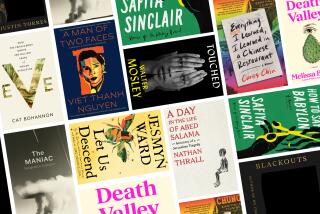Cao Dai Fuses Great Faiths of the World
- Share via
During the 1960s, historian and Vietnam watcher Bernard Fall described Cao Dai -- the eclectic Vietnamese religion whose saints include William Shakespeare and Victor Hugo -- as a “dinosaur,” headed for oblivion after peaking in the 1950s.
Not so, says Janet Hoskins, a USC anthropology professor who is writing a book on Cao Dai. Both in Vietnam and places like Southern California where Vietnamese have settled, the faith is undergoing a renaissance, she said in an interview this week.
There are about 20 Cao Dai churches or temples in California, including one in Pomona, serving about 25,000 people in all, according to Hoskins. And now that the Socialist Republic of Vietnam recognizes the faith, Cao Dai temples have increased to about 1,300 in the nation that gave birth to the complex fusion religion in 1926.
In November, ground was broken for a Cao Dai temple at 8971 Orangewood Ave. in Garden Grove. To be constructed on the same spirit-dictated plan as the elaborate main temple in Tay Ninh, Vietnam, the smaller Orange County version will cost about $2 million, said Hum Bui, a Cao Dai leader who lives in Redlands. About $500,000 has been raised, and grading of the site has begun, he said. The temple is expected to be completed by the end of 2007.
“We’ve really been longing to have the temple built,” said David Che, a dentist in Irvine who has contributed to the building fund. The temple will be a visual guide to the esoteric teachings of the faith, he said.
“It will attract converts and bring unity to the community and help people learn more about the religion,” Che predicted.
A decade ago, local Cao Dai leaders noted a lack of interest in the religion among the younger generation. Today, according to Bui and others, there are more young people in local temples. And Bui said he receives many e-mails from youth who say they have been seeking spiritual answers and are happy to have discovered Cao Dai.
Adherents of the faith believe that the Supreme Being is the source of the world’s great religions, including Buddhism, Taoism, Confucianism, Christianity, Islam and Judaism. And they believe that the Supreme Being sent a spirit message to Cao Dai founder Ngo Minh Chieu saying all these religions should be united into a single new faith.
A physician as well as a Cao Dai leader, Bui, 62, devotes much of his time to translating the texts and complexities of his faith into English. He said the religion tends to be practiced a little differently in the U.S. than in Vietnam.
There, Cao Dai has an elaborate compound and brightly colored cathedral-like temple in Tay Ninh. Known as the Holy See (Cao Dai has had a succession of popes), the complex is one of the biggest tourist draws in Vietnam. Novelist Graham Greene once described the temple, with its dragon-wrapped pillars and Mardi Gras hues, as a “Walt Disney fantasy of kitsch.”
Because Southland temples are widely scattered, Bui performs his daily prayers before his home altar, in the form of silent meditation. Once a week or every two weeks, he goes to a temple for ritual prayer, chanted by congregants in front of the altar. In the temples, practitioners usually wear white robes, while temple dignitaries may wear robes of turquoise, yellow or red.
In Vietnam, Cao Dai adherents go to temple each month at the full moon and the new moon. And they abstain from eating meat around those times. Here, Bui said, most go to temple on Sunday, when they tend to be free of the professional obligations of the American workweek.
Bui said the main teachings of almost all religions are the same -- love and justice. By love, he said, he means unselfish love. By justice, he means “to not do what you don’t want done to you.” Asked if he ever received spirit communications, Bui said: “I’m not sure, but I believe I receive guidance from the Supreme Being.”
Founder Chieu said he saw the left eye of God (the symbol of the faith) in a vision. He also said he received inspired messages during seances that used a traditional Chinese divining basket. An official in the French colonial government, Chieu became Cao Dai’s First Disciple.
“Cao Dai means ‘Supreme Being,’ but there’s also a pantheon,” Hoskins said. The pantheon has five levels. At the top is Buddha and others who have achieved Buddha-hood. Next are the Great Immortals, including Confucius, the Chinese poet Li Po and the Mother Goddess.
On the third tier are the Saints, including writers Shakespeare and Victor Hugo, Jesus, Muhammad, Moses, Joan of Arc, Louis Pasteur, Asian nationalist Sun Yat-sen, Lenin and Vietnamese poet and prophet Trang Trinh. Venerated spirits or ancestors, including all those who give their life for their country, occupy the fourth level. Humanity makes up the fifth.
The many holy faces that appear on a Cao Dai altar tend to confuse the uninitiated.
“People think we are polytheists, but we’re not,” said Che, 41. “We believe in one God. But there are many prophets, many messengers.”
For outsiders, one of the least likely messengers is 19th century French poet and novelist Hugo. According to Hoskins, the writer appealed to early Cao Daists because of his interest in spiritism. In a posthumously published account of his seances, Hugo foresaw the rise of a new faith uniting Asian and Western spirituality.
Cao Dai followers do not worship Hugo, Hoskins said. “Victor Hugo is there almost like John the Baptist. He’s a prophet who predicted that this Asian vision would become important in the 20th century.”
Joan of Arc joined the pantheon after she reportedly contacted Cao Dai mediums and expressed sympathy for their struggle for Vietnamese independence. According to Hoskins, the Maid of Orleans is believed to have said, in effect: “I was a soldier in a liberation army, just as you are, seeking your freedom from the occupying French. Your struggle was my struggle.”
Through spirit mediums, Joan of Arc is also believed to have pointed out that Cao Dai is the rare faith that gives full equality to women. “They have grandmothers who are cardinals,” Hoskins said.
Cao Dai has been both a player in and witness to the tumultuous modern history of Vietnam. During the 1930s, it acquired millions of followers, alarming the French, who spied on the church and sometimes imprisoned its leaders.
In 1941, believing that the church sought a Japanese victory, the French closed its temples and sent its seven most important leaders into exile in Madagascar.
After Saigon fell to the North Vietnamese in 1975, Cao Dai, like other religions, was suppressed. It was officially recognized by the state in 1997 and has been growing ever since, Hoskins said.
Cao Dai is a religion of tolerance, and its adherents are expected to love their enemies, even the Communists who persecuted them: “They are just one of our brothers or one of our children who happened to go on the wrong path,” Bui said.
More to Read
Sign up for Essential California
The most important California stories and recommendations in your inbox every morning.
You may occasionally receive promotional content from the Los Angeles Times.










